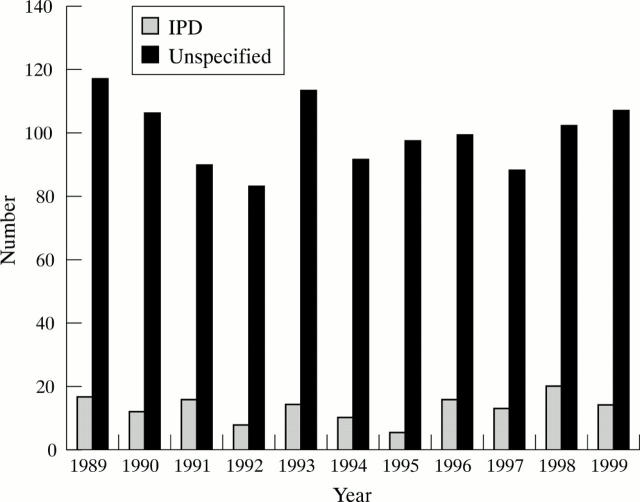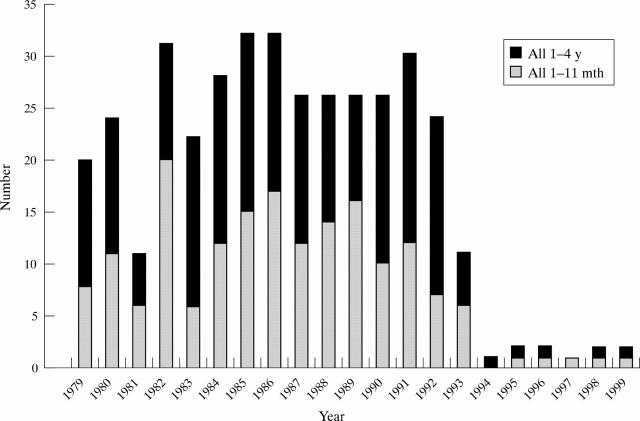Abstract
Background: The annual reported incidence rates for laboratory confirmed invasive pneumococcal disease (IPD) underestimate the true burden of invasive disease attributable to pneumococcal infection.
Aims: To estimate the proportion of "unspecified" mortality of infectious cause in infants and young children aged 1 month to 4 years reported by the Office for National Statistics (ONS) in England and Wales that could reasonably be attributed to IPD, thereby revising the total number of deaths per year potentially attributable to IPD, and producing a more accurate figure for the number of deaths that may be prevented by a programme of pneumococcal conjugate vaccination.
Methods: Polymerase chain reaction, latex agglutination, and other alternate methodologies to microbiological culture have been applied in various studies to the detection of Streptococcus pneumoniae. Some of these tests have been shown to be more sensitive indicators of pneumococcal infection. In our analysis the implications of these tests were applied theoretically to the "unspecified" clinical deaths caused by septicaemia, meningitis, and pneumonia reported by the ONS, with a 20% correction/reduction factor for nasopharyngeal carriage which these sensitive tests may coincidentally detect.
Results: The ONS reported an average of 13 deaths per year (1989–99) in infants and children aged 1 month to 4 years caused by pneumococcal septicaemia, meningitis, or pneumonia. By applying the rates for the more sensitive tests to the most recent ONS "unspecified" mortality data available (1999), the actual annual number of deaths caused by IPD in the age group 1 month to 4 years is shown to be at least as high as 43.
Conclusions: The mortality as a result of IPD in infants and young children may be at least three times the reported rate. The 7 valent pneumococcal conjugate vaccine may have the potential to prevent up to 26 (61%) of the IPD deaths per year in infants and young children in England and Wales alone.
Full Text
The Full Text of this article is available as a PDF (111.7 KB).
Figure 1 .
IPD and unspecified meningitis, septicaemia, and pneumonia deaths, 1989–99, in England and Wales reported to ONS.
Figure 2 .
H influenzae deaths, 1979–99, in England and Wales reported to ONS.
Selected References
These references are in PubMed. This may not be the complete list of references from this article.
- Black S., Shinefield H., Fireman B., Lewis E., Ray P., Hansen J. R., Elvin L., Ensor K. M., Hackell J., Siber G. Efficacy, safety and immunogenicity of heptavalent pneumococcal conjugate vaccine in children. Northern California Kaiser Permanente Vaccine Study Center Group. Pediatr Infect Dis J. 2000 Mar;19(3):187–195. doi: 10.1097/00006454-200003000-00003. [DOI] [PubMed] [Google Scholar]
- Booy R., Hodgson S. A., Slack M. P., Anderson E. C., Mayon-White R. T., Moxon E. R. Invasive Haemophilus influenzae type b disease in the Oxford region (1985-91). Arch Dis Child. 1993 Aug;69(2):225–228. doi: 10.1136/adc.69.2.225. [DOI] [PMC free article] [PubMed] [Google Scholar]
- Cherian T., Lalitha M. K., Manoharan A., Thomas K., Yolken R. H., Steinhoff M. C. PCR-Enzyme immunoassay for detection of Streptococcus pneumoniae DNA in cerebrospinal fluid samples from patients with culture-negative meningitis. J Clin Microbiol. 1998 Dec;36(12):3605–3608. doi: 10.1128/jcm.36.12.3605-3608.1998. [DOI] [PMC free article] [PubMed] [Google Scholar]
- Dagan R., Shriker O., Hazan I., Leibovitz E., Greenberg D., Schlaeffer F., Levy R. Prospective study to determine clinical relevance of detection of pneumococcal DNA in sera of children by PCR. J Clin Microbiol. 1998 Mar;36(3):669–673. doi: 10.1128/jcm.36.3.669-673.1998. [DOI] [PMC free article] [PubMed] [Google Scholar]
- Isaacman D. J., Zhang Y., Reynolds E. A., Ehrlich G. D. Accuracy of a polymerase chain reaction-based assay for detection of pneumococcal bacteremia in children. Pediatrics. 1998 May;101(5):813–816. doi: 10.1542/peds.101.5.813. [DOI] [PubMed] [Google Scholar]
- Miller E., Waight P., Efstratiou A., Brisson M., Johnson A., George R. Epidemiology of invasive and other pneumococcal disease in children in England and Wales 1996-1998. Acta Paediatr Suppl. 2000 Dec;89(435):11–16. doi: 10.1111/j.1651-2227.2000.tb00776.x. [DOI] [PubMed] [Google Scholar]
- Toikka P., Nikkari S., Ruuskanen O., Leinonen M., Mertsola J. Pneumolysin PCR-based diagnosis of invasive pneumococcal infection in children. J Clin Microbiol. 1999 Mar;37(3):633–637. doi: 10.1128/jcm.37.3.633-637.1999. [DOI] [PMC free article] [PubMed] [Google Scholar]
- Zhang Y., Isaacman D. J., Wadowsky R. M., Rydquist-White J., Post J. C., Ehrlich G. D. Detection of Streptococcus pneumoniae in whole blood by PCR. J Clin Microbiol. 1995 Mar;33(3):596–601. doi: 10.1128/jcm.33.3.596-601.1995. [DOI] [PMC free article] [PubMed] [Google Scholar]




